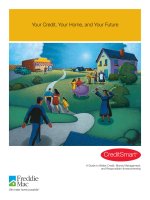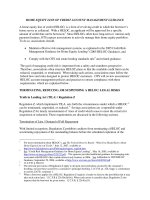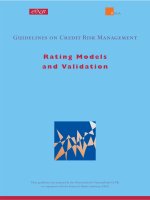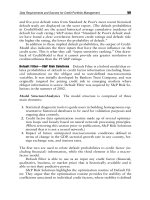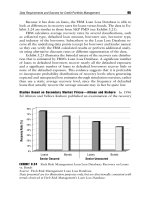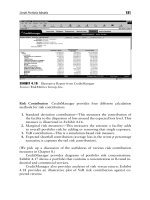Vinamilk Credit Lending Management
Bạn đang xem bản rút gọn của tài liệu. Xem và tải ngay bản đầy đủ của tài liệu tại đây (1.33 MB, 25 trang )
HANOI UNIVERSITY
FACULTY OF MANAGEMENT AND TOURISM
VIETNAM DAIRY PRODUCTS JOINT STOCK COMPANY
CREDIT ANALYSIS AND LENDING
MANAGEMENT
Lecturer: Đào Thị Thanh Bình
Tutor: Nguyễn Thị Minh Hằng
01
Tutorial Number: 04
Group number: Nguyễn Thị Hà – 1704040027
Nguyễn Thị Hoa – 1904040046
Group Members: Đào Thị Nga - 1904040081
Nguyễn Hồng Nhung - 1904040094
FALL 2022
TABLE OF CONTENTS
ACKNOWLEDGEMENT ......................................................................................................... 1
ABSTRACT ............................................................................................................................... 2
I. Introduction to Borrower – Vietnam Dairy Products Joint Stock Company .........3
II. Vinamilk Analysis ..................................................................................................... 4
1. Expert System – 5Cs ................................................................................................. 4
1.1. Character ................................................................................................................... 4
1.2. Capacity ..................................................................................................................... 5
Table 1: Capacity Ratio ......................................................................................................... 6
1.3. Cash – Financial Performance of Vinamilk............................................................6
Liquidity Analysis ..................................................................................................... 6
Table 2: Liquidity Ratio ......................................................................................................... 6
Efficiency analysis ..................................................................................................... 7
Table 3: Efficiency Ratio........................................................................................................7
Profitability analysis ................................................................................................. 9
Table 4: Profitability Ratio .................................................................................................... 9
Leverage Ratio.........................................................................................................10
Table 5: Leverage Ratio ....................................................................................................... 11
1.4. Collateral..................................................................................................................12
1.5. Condition..................................................................................................................14
2. Risk Premium Analysis .............................................................................................. 14
Table 6: Probability of Repayment WITHOUT Recovery Rate ........................................... 15
Table 7: Probability of Repayment WITH Recovery Rate ................................................... 15
3. Econometric Analysis ................................................................................................. 16
Table 8: Discriminant Zone ................................................................................................. 16
Table 8: Vinamilk’s Altman Z score.....................................................................................17
III. Conclusion and Decision for the Loan ...................................................................... 18
REFERENCE ......................................................................................................................... 19
APPENDIX ............................................................................................................................. 20
ACKNOWLEDGEMENT
We would like to thank Dr. Dao Thi Thanh Binh and Mrs. Nguyen Thi Minh Hang for their
time and excitement in providing us with feedback on this project. We would like to use this
time to express our sincere gratitude to our friends and coworkers for their commitment to
helping us finish this project. We are motivated to retain the knowledge we learn during the
course by the outcome and practicality of the project.
1|Page
ABSTRACT
In current development and integration economics, corporations, medium and small
enterprises are important departments in the economy and society in Vietnam. To continuously
strongly improve and widen scales, requires abundant resources and stable capital from banks
or financial institutions. As a commercial bank, playing the blood economy, intermediary
bridge between excess capital and shortage of capital, the following report is going to present
a credit appraisal report of VINAMILK – Vietnam Dairy Products Joint Stock Company,
including the analysis of financial performance, five Cs of the company and others. With the
purpose of answering the questions: Should the loan support for VINAMILK or not?
2|Page
I. Introduction to Borrower – Vietnam Dairy Products Joint Stock Company
Vietnam Dairy Products Joint Stock Company (Vinamilk) is consistently determined to be a
premium brand in the food and beverage industry, with a large number of domestic and
international customers who are served a variety of nutritional and health products. Established
on August 20, 1976, Vinamilk is a well–known corporation focusing on milk, probiotics,
yogurt, ice cream, soft drinks, coffee, and other products derived from milk. Vinamilk has a
system of factories not only in domestic but also in international nations. Spreading from Thanh
Hoa, Nghe An, Da Nang, Tuyen Quang, Ha Tinh, Lam Dong, Myanmar, Thai Lan, New
Zealand, and 20 other countries, Vinamilk is increasingly becoming a solid brand name in the
market. To become a milk industrial leader, Vinamilk has concentrated on product quality and
reputation, as well as customer satisfaction. In the era of the "4.0" technology revolution,
Vinamilk has been one of the listed firms paying attention to technology as well as international
cooperation.
Although COVID-19's outbreak caused the entire global economy to decline, the dairy industry
in Vietnam even grew and was little harmed. Dairy industry experts stated that while Vietnam
currently has a low per capital milk consumption, the dairy business is still seen as having
potential in the future. The demand for raw, fresh milk surged by roughly 61%, from 500
million liters in 2010 to 805 million liters in 2015, according to data from the Vietnam Feed
Association (VFA). Vietnam is a large nation with a population growth rate of 1.2% annually,
and the dairy industry there has a lot of potential. The GDP is expected to expand by 6–8% a
year, and per capita income is expected to rise by 14.2% annually, which combined with the
trend of improving the health and stature of the Vietnamese people will increase demand for
products. Milk always has a high growth rate. Each Vietnamese person consumed roughly 15
liters of milk annually in 2010, on average. The amount of milk consumed annually per person
is expected to nearly treble to 28 liters by 2020. Numerous businesses and organizations have
come and gone as the dairy sector has grown in recent years; some of them, including TH True
Milk, Dutch Lady, Nestle, Nuti-Food, and others, have enjoyed notable success. Vietnam Dairy
Products Joint Stock Company, which was named one of the top 200 best revenue-generating
listed companies in Asia Pacific in 2019 (Forbes Asia), is focused on this project (VNM).
Vinamilk has been growing for at least 40 years and has progressively consolidated its position
in the market.
3|Page
The first problem affecting Vinamilk's operations is the rural population's high percentage of
low-income residents. Lower income individuals will limit the consumption of the nation's
output, which will lower profits and sales revenue for the corporation if the economy's growth
slows down in the upcoming term.
Additionally, lowering dairy product duties will provide beneficial circumstances for imported
dairy products. The company's operations are impacted by exchange rate swings because it
imports 50% of its raw materials and generates 30% of its income from exports. Finally, Viet
Nam's WTO membership will make it possible for international businesses to enter the
domestic market. As a result, the industry's enterprises will face more competition.
To reach its market leader position in the Vietnam market, VNM keeps customer loyalty and
performs effective competitive strategies. Milk sector is where customer loyalty might change
if the firm is satisfied with its current position and has no new innovations.
II. VINAMILK Analysis
1. Expert System – 5Cs
1.1.Character
First of all, Vinamilk from the beginning has determined that this is the unit that plays a pivotal
role in the production and supply of fresh cow's milk raw materials to supply to processing
factories with the head of Mrs. Mai Kieu Lien. The company's activities are quite diverse,
including: dairy farming; mixed farming and animal husbandry; production of animal, poultry
and aquatic feed; wholesale agricultural, forest products raw materials and live animals; agents
(cow semen, veterinary drugs, animal feed, ...). Initially, the farm had a total herd of about
1,400 dairy cows with a total workforce of 92 people. Up to now, the company's charter capital
has reached 1,550 billion VND with the total number of employees up to 480 people.
The encouraging maturity of the corporation after 8 years of efforts to carry out the mission is
expressed through various achievements. Top 10 Vietnamese high quality product by the
Association of Vietnamese High Quality Products (1995-2020), Vinamilk is ranked number
one in Forbes Vietnam's "Top 50 Most Valuable Brands" (2016-2020). Besides, there are many
international achievements, such as the Top 200 Asia's Best Over A Billion (Forbes Magazine,
2019), the Top 10 World's Most Valuable Dairy Brands, the Top 3 World's Most Potential
Dairy Brands, and the Top 5 World's Strongest Food Brands (Brand Finance’s Annual Report
2020 (United Kingdom)).
4|Page
Currently, all dairy barn systems are invested in and built by the Vinamilk company according
to the world's most modern technology, making the best quality of products and the highest
quantity of products and services. Therefore, Vinamilk profit goes toward the benefit of the
customer, that means they always bring belief to the consumer. In order to master modern
technology and equipment, the company pays great attention to training and developing human
resources. Every year, about 10 students with good/excellent university entrance exam results
are selected and sent by the Company to train in the Russian Federation on dairy farming.
Based on the importance of investing in human resources as a key factor, Vinamilk company
has the prospect of effectively implementing the proposed long-term investment strategies.
Additionally, in accordance with the State Securities Commission's rules, Vinamilk
consistently releases complete financial statements as a business that was listed on the Ho Chi
Minh Stock Exchange in 2006. Finally, all of this raises Vinamilk's value and establishes it as
a trustworthy company.
1.2.Capacity
Capacity is the ability to repay the loan with interest as per the predetermined schedule. (Here
'capacity’ refers to financial capacity to repay the loan. Capacity is different from legal
capacity, which refers to capacity or eligibility to enter into a loan contract.) Capacity depends
on two factors. The first factor is the borrower's financial position that should be stable. The
second is the borrower must be able to generate sufficient net income to service the loan
repayment.
To analyze whether the borrower’s financial position is stable, lenders often seek financial data
from the customer. In the case of personal loans, borrowers are often required to give details
of income and expenditure, and the net surplus available for repayment. The lender also finds
details of the existing assets and liabilities of the borrower. Assets may consist of property,
investment in stocks, managed funds and/or term deposits. Liabilities may consist of
outstanding balances on loans and credit cards.
Lenders typically want audited financial statements and predicted cash flow in the case of
businesses to assess the borrower's financial health or creditworthiness. The lender takes into
account both the risks and profits of the new initiative that the company is proposing. The main
source from which repayment is anticipated to occur is capacity. At the outset, it's crucial to
evaluate the main sources of debt payback.
To analysis the ability to repay loan of Vinamilk, lenders often consider DIT ratio.
5|Page
Total Debt
Debt – to – Gross income = Revenue
Year 2019 2020 2021
28.65%
Debt – to Gross income 26.54% 24.76%
Table 1: Capacity Ratio
From the table, the lender can see that the debt-to-equity ratio decreases slightly from 2019 to
2020. After that, this ratio showed an upward trend between 2020 and 2021. This ratio has been
less than 50% for all three years; the total debt of the company is less than the revenue from
sales of goods and services. So lenders can conclude that this accounts for only a small portion
of the company's total revenue, so the company is less likely to have bad debt. On the other
hand, the company is financing its operations mainly from the owner's capital contribution and
from the accumulated after-tax profit over the years. This shows that the enterprise can be
financially independent and does not need to borrow too much, thus reducing the financial
pressure on the business and minimizing interest and expense, thereby improving business
results.
Moreover, Vinamilk is also considered a company with strong financial health and a leading
company in the milk market in Vietnam. Vinamilk is also among the top 30 enterprises with
the largest capitalization index in Vietnam. Not only being successful in Viet Nam, Vinamilk
is also very successful abroad, with milk exports to more than 40 countries around the world.
Vinamilk's financial strength and reputation are indisputable, so lending to this company has
very little risk.
1.3.Cash – Financial Performance of Vinamilk
Liquidity Analysis
Years 2019 2020 2021
Current Ratio 1.81x 1.90x 2.10x
Quick Ratio 1.37x 1.74x 1.72x
Table 2: Liquidity Ratio
Liquidity indicators reflect the ability of the business to pay off short-term loans. Generally,
Vinamilk’s Current Ratio and Quick Ratio is higher than 1 times (which is considered as
benchmark), which has remained stable and safe over the years. Beside, the growth of current
assets over current liability is uptrend, expressing Vinamilk's ability of controlling leverage
6|Page
relatively well, increased by 2.1 times compared to the previous year. The acid test ratio
evaluates a company's capacity to settle its immediate obligations without having to sell
inventory or seek out additional funding, which has benchmark equal 1, meaning be normal
quick ratio. Acid test ratio of Vinamilk is almost higher than 1, even rising up 1.74 times in
2020 and adjusted slightly at 1.72 times in 2021, that means Vinamilk has 1.72 (VND) of liquid
assets available to cover each 1 (VND) of current liabilities. Looking at the graph, we can easily
see the trend line of Vinamilk's liquidity ratio during the recent 3 years.
Finally, it can be concluded that Vinamilk has comparatively sound financial standing and the
acceptable capacity to repay short-term loans, as a result, the first criterion of Vinamilk's
financial performance supports this decision to take out a short-term loan.
Efficiency analysis
Year 2019 2020 2021
2.3x 1.9x
Account Receivable Turnover 2.3x 3.8x 7.1x
12.2x 9x
Account Payable Turnover 3.9x 32 days 35 days
56 days 71 days
Inventory Turnover 11.3x 170 days 170 days
The average collection period 29 days
Days Inventory Held 61 days
Days Accounts Payable Outstanding 150 days
Table 3: Efficiency Ratio
We stated earlier that one of the characteristics of a financially sound business is that it is run
efficiently. To measure efficiency, financial analysts calculate the efficiency ratios. The
efficiency ratios measure how efficiently the business has employed its assets. These ratios are
based on the relationship between the level of activity (represented by sales or the cost of goods
sold) and the levels of various assets. The important efficiency ratios are:
The inventory turnover ratio
The average collection period.
The inventory turnover ratio
The inventory turnover ratio shows the efficiency of management of inventory. The ratio of
net sales to inventory is called the inventory turnover ratio.
Net Sale
Inventory turnover ratio = Inventory
For Vinamilk company, the inventory turnover was:
7|Page
11.3x in 2019
12.2x in 2020
9x in 2021
The inventory turnover ratio of Vinamilk is between 9.0 and 12.7. There is no benchmark for
this ratio because the type of inventory determines what the ratio should be. The inventory ratio
of Vinamilk is very high because the company is producing and selling daily necessities –
products from milk.
A high ratio would indicate that the inventory is fast moving and that the products of the
business are in high demand. The ratio of Vinamilk is quite high so it is good. It means that the
inventory management of the business is very efficient.
The average collection period
This ratio shows the efficiency in collection of receivables. A business that is efficient in
debt collection will face fewer liquidity problems. The average collection period is the ratio
of receivables to average sales per day. The average collection period is calculated by the
Receivables
following formula: Average Collection Period = Average sales per day
For Vinamilk, the average collection period was
29 days in 2019
32 days in 2020
35 days in 2021
The average collection period should be equal to or less than the firm’s credit terms for its
customers. If it is the policy of Vinamilk to allow up to one month’s credit only, then the ratio
as above is unsatisfactory. The firm's credit policy is usually determined according to the
general market practice. New firms generally allow a longer credit period to penetrate the
market. Similarly, firms may allow a longer credit period when introducing new products. If
the average collection period calculated by the above formula is less than the credit term
generally allowed by the firm, then the debt collection of the firm can be regarded as efficient.
Account Receivable Turnover
The Account Receivable Turnover of Vinamilk decreased slightly from 2.3x to 1.9x from 2019
to 2021. This index is generally quite good, its downtrend is not a good sign. because the
receivables turnover ratio is higher each month/quarter/year. Thus, it is confirmed that the debts
and receivables have been effective. This means that Vinamilk is not in a positive financial
position in 2021.
8|Page
Account Payable Turnover
The Account Payable Turnover of Vinamilk rose strongly from 2019 to 2021 (3.9x to 7.1x).
This index is generally quite high. That proves the financial health of this company is quite
good. The reason is that the higher the payables turnover ratio, the better the debt payment
ability of the business and the strong financial position of the business.
Day Inventory Held
Day Inventory Held of Vinamilk was an average number, but it had an upward trend between
2019 to 2021. Because this metric shows the length of time a company's cash is stuck in
liquidity because of unsold inventory. This data is higher because the company may want to
keep inventory high to achieve high order fulfillment rates, for example because the company
predicts strong sales for the coming year.
Days Accounts Payable Outstanding
This number is an upward tendency from 2019 to 2021. An increase in this index may indicate
that Vinamilk is using available cash for short-term investments and increasing working capital
and free cash flow (FCF).
Profitability analysis
Year 2019 2020 2021
Profit after tax/ Revenue
Profit after tax/ Equity (ROE) 19% 19% 17%
Profit after tax/ Total Assets (ROA)
Operating profit/ Net revenue 38% 35% 31%
26% 24% 21%
23% 23% 21%
Table 4: Profitability Ratio
The year 2021 witnessed negative impacts from the COVID pandemic on Vinamilk. However,
through efforts to expand the business and control costs, the Company’s profit margins
remained high regardless of the modest year-over-year decrease.
Return on Assets (ROA)
This ratio demonstrates how well assets are used to produce income. Since it is calculated by
dividing net income by total assets, in general, the greater the rate of return, the more
successfully the company turns its investments into net income. Vinamilk's ROA may still be
regarded as a high rate and produced more money on less investment even though there was a
9|Page
slight reduction over the five-year period compared to the industry average ROA, which is
0.27, according to Investing.com research in 2021.
Return on Equity (ROE)
ROE is a metric used to assess a company's profitability in relation to stockholder equity. By
using the result calculated by dividing net income by shareholders' equity. The best way to use
ROE is to compare the statistic to the industry average, which is 28.88%. It is obvious that
VINAMILK's ROE exceeds industry averages by up to 8.27%. The difference between these
percentages is acceptable because a typical ROE may be 10% or less than the industry standard.
Operating profit performance
By dividing operating income over total revenue, this metric expresses how the company
generates its profit on a per-sale basis after considering variable costs except any interest or
taxes (EBIT). In the VINAMILK case, the operating profit margin had slightly fallen off from
2019 to 2021 by 1.03. Though, using the average in the dairy industry in 2021 (20.94%),
Vinamilk can still be considered as a strong firm in maximizing its operations and profit.
Revenue growth
In the context that the Vietnam economy began to show signs of recovery after the pandemic,
in the first quarter of 2022 (“1Q2022”), Vinamilk’s consolidated net revenue continued the
uptrend at 5.2% YoY growth, reaching VND 13,878 billion and completed 21.3% of the annual
guidance (VND 64,070 billion). According to the General Statistics Office (GSO), total retail
sales of goods and consumer services in 1Q2022 increased by 4.4% YoY. Vietnam is currently
one of the six countries with the highest COVID-19 vaccination rate in the world.
Net cash balance as of 30 September 2021 was VND 12,686 billion, equivalent to 24% of total
assets. Total capital expenditure in 9M2021 was more than VND 1 trillion. For the whole
group, Vinamilk is operating a network of 17 local and overseas factories, 15 dairy farms with
a total herd of cows reaching nearly 160,000.
Leverage Ratio
Liabilities to asset ratio
Controlling the financial situation of the business is an extremely important issue of the
business. The tool that owners prefer to use is the ratio of total debt to total assets. A company's
debt-to-assets ratio is one of the groups of debt ratios or leverage ratios included in a financial
10 | P a g e
ratio analysis. The debt-to-assets ratio indicates the percentage of total assets paid for with
borrowed money, represented by debt on a business company's balance sheet. About Vinamilk
company, we can calculate liabilities to asset ratio based on formula:
Total Liabilities
Liabilities to asset ratio = Total Assets.
Year 2019 2020 2021
0.3053x 0.3278x
Liabilities to asset ratio 0.3349x 0.4394x 0.4876x
0.0271x 0.0263x
Liabilities to shareholders equity ratio 0.5035x 0.0173x 0.0177x
Long term debt to long term capital ratio 0.0417x
Long term debt to shareholder’s equity ratio 0.0251x
Table 5: Leverage Ratio
We can see from the table, liabilities to asset ratio tends to decrease slightly (approximately
2.96%) from year 2019 to 2020. A Vinamilk company with a reduced liability to asset ratio
indicates a company with less liabilities. This is a good sign of the company's financial health.
But from 2020 to 2021, it shows signs of increasing again (about 2.25%) indicating that the
company is at a disadvantage in terms of revenue prospects and poor long-term growth that
will affect retained equity.
Liabilities to shareholder equity ratio
Liabilities to shareholder equity ratio is the ratio between the capital raised by the business by
borrowing to the capital invested by the owners. Liabilities to shareholder equity is calculated
formula below:
Liabilities to shareholder equity = Total Liabilities Total shareholder’s equity
According to the table, liabilities to shareholder equity had a strong decrease from 0.5035x to
0.4394x during the first two years. A high liability to shareholder equity ratio shows that a
business uses a lot of debt to finance its business. If it is reduced, it shows that the company's
capital for operations is abundant equity, low debt, not under much financial pressure and is
doing business effectively. However, from 2020 to 2021, liabilities to shareholder equity ratio
will increase to 0.4876x. If it increases, it shows that the company's ability to repay debts is
difficult.
11 | P a g e
Long term debt to long term capital ratio
Long term debt to long term capital ratio is calculated using the formula:
Long term debt to long term capital ratio = Long term debt Long term capital
Overall, it is easy to see that the long term debt to long term capital ratio percentage of Vinamilk
company follows the downward trend from 2019 to 20120. In 2019, the long term debt to long
term capital ratio was only 0.0417x at the end of the year, however on 31 Dec 2020, it decreased
to 0.0271x (reduced approximately 2% compared to the previous year). Coming to next year –
2021, Vinamilk company has a drop in long term debt to long term capital ratio (with at
0.0263x).
Long term debt to shareholder’s equity ratio
The long-term debt to shareholder’s equity ratio is a solvency measure that shows how much
financial leverage a company has. The long-term debt to shareholder’s equity ratio formula is
calculated by dividing long-term liabilities by total shareholder’s equity.
Based on the table, the long term debt to shareholder’s equity ratio ranges from 0.0251 times
to 0.0177x and tends to increase and decrease over the years and the highest is in 2019.
However, by 2020, this rate will decrease to 0.0173x. Entering 2021, this rate suddenly
increased to 0.0177 (about 0.04%). Rising long term debt to long term capital ratio make
Vinamilk company feel secure to lend without fear of bad debt. An increase in this ratio
indicates that the company's investments are less risky, since debt is the main source of
financing and is the cause of a higher risk of a decrease in solvency.
1.4.Collateral
One of the crucial factors in assessing the quality of the loan is Collateral, which is considered
as the secondary source of repayment. When a loan can not be repaid out of the primary source,
banks require collateral in case of unforeseen events to reduce the risk of default for the loan.
Mortgages, machinery, account receivable or even saleable inventory are examples of collateral
in corporate loans.
First of all, we need to identify several types of Vinamilk’s assets considered as collateral. Until
now, Vinamilk system of 13 factories connecting with 13 dairy farms across the country, Tien
12 | P a g e
Son Dairy Factory in the North, Da Nang Dairy Factory, Binh Dinh Dairy Factory, Can Tho
Dairy Factory in the Southwest region, are some examples. According to tuoitre.vn, Vietnam
Powdered Milk Factory and Vietnam Dairy Products Factory are two factories that are
classified as "super factories" owing to its modern automatic technology. Almost all Vinamilk's
factories also equip modern technology to improve productivity and quality of product and
services, therefore, Vinamilk is able to currently cover the demands of both the domestic and
foreign markets by producing 5.1 million liters of liquid milk per day, which equivalent to more
than 28 million milk cartons. Besides, Vinamilk owns Ho Chi Minh and Ha Noi warehousing
Enterprise, including raw materials for production and serving finished products for export.
One of the secured assets is tangible and intangible fixed assets, until to the ending of year of
2021 Vinamilk owns a large amount of fixed assets, including tangible fixed assets accounting
for 90% of total fixed assets, which is building and structures, machinery and equipment, motor
vehicles, office equipment, etc; and intangible fixed assets such as land use rights, trademark,
raw materials, software and etc. However, Vinamilk’s fixed assets are downtrend during the
last three years, therefore, it is needed to assess more detail if using collateral for the loans.
Furthermore, Vinamilk's inventory is one of the specialty products with shelf life regulations,
but the company has applied the EOQ model to its inventory management, and its inventory is
currently about 6,820 billion VND, falling to 5,792 billion VND until the third quarter of 2022.
The types of inventory are primarily raw materials and finished goods, which are also
considered secured assets for the loan.
The last secured asset we mention is accounts receivable.
Looking at the above table, Vinamik’s account receivable is up to 5,954 billion VND in the
third quarter of 2022, increasing slightly compared to the first quarter of 2022. The main
sources of receivables are accounts receivable from customers; the remaining are prepayments
13 | P a g e
to suppliers and others. Due to its short term, all of them recover within 12 months. With
Vinamilk's account receivables, it can be assumed Vinamilk will fully repay the loans after
recovering; therefore, that is considered collateral for the loan.
It is concluded that the secondary sources of Vinamilk repayment are quite various, but it is
necessary that we need to experience reality in Vinamilk to more accurately analyze before
making the loan decision.
1.5.Condition
A considerable number of factors make a great contribution to the business activities of the
firm, divided into external and internal factors. The initial one is widely beyond the control of
the company due to factors such as government policies, natural disasters, technological
advances, rationalization, and globalization. With current macroeconomic circumstances,
world inflation is strongly increasing, therefore prompting most major central banks in the
world to accelerate the tightening process and raise interest rates to control inflation. Even if
the inflation rate in Vietnam is relatively low compared to other economies (about 4% as of
September 2022), SBV has researched and introduced annual-oriented credit targets to control
inflation, stabilizing the money market. As a result, before making a loan decision, the bank
must carefully consider all of its options. In this case, the bank considers whether VINAMILK
would be a potential customer.
Furthermore, the internal factors that are under the regulation of Vinamilk can be mentioned
as the management style and the structure. After assessing and analyzing some of the
aforementioned Vinamilk factors, we believe that the company has an effective administrative
system and professional culture, as well as a leadership and management style that has
contributed to customer trust in the quality of its products and services over the years.
2. Risk Premium Analysis
The risk premium is the difference between the required rate of return on a conventional
investment, versus the rate of return on a risk-free investment. It is a form of compensation for
holding higher risk assets. The risk premium represents the relationship between risk and
expected return, with the higher the risk, the higher the return an investor is expected to receive.
It will be different for investors with different risk appetites. Risk-averse investors will tend to
demand a higher rate of return than risk-averse investors.
14 | P a g e
To obtain the data of the interest rate of the corporate bond (i) and the risk free rate (r), we take
information from Vietnam credit. We determine the same maturity for treasury bond and
corporate bond interest rate applied by Vinamilk for a one-year working capital loan. We
understand zero-interest corporate bonds with a BB rating of 5.50% based on Fitch's Vietnam
credit rating.
Without recovery rate, based on the formula: p = 1+ i , we can calculate the probability of
1+ r
repayment (p) from 2019 to 2021.
Year 2019 2020 2021
The interest rate on the corporate bond (r) 5.5% 5.5% 5.5%
The risk free rate (i) 3.386% 2.451% 2.123%
Probability of Repayment (p) 98.00% 97.11% 96.80%
Table 6: Probability of Repayment WITHOUT Recovery Rate
According to the above table, the probability of repayment decreases to 1.2% because the risk
free rate reduces from 2019 to 2021. In 2019, the debt has a 98% chance to be repaid and a 2%
probability of defaulting and risk premium is 2%. In 2020, the debt has a 97.11% chance to be
repaid and a 2.89% probability of defaulting so the risk premium is 3%. In2021, the debt has a
96.8% chance to be repaid and a 3.2% probability of defaulting then risk premium is more than
3%.
With Recover rate, based on the financial performances and 5Cs is analyzed above, we assume
that the recover rate (e) = 70%, we have the data of Risk Premium via the formula:
1+ i
r − i = e + p − pe − (1 + 𝑖)
Year 2019 2020 2021
Probability of Repayment (p) 93.32% 90.36% 89.33%
Risk Premium (r - i) 2.114% 3.049% 3.377%
Table 7: Probability of Repayment WITH Recovery Rate
15 | P a g e
Looking to the table, we can easily see that with the recovery rate, the repayment capacity has
decreased slightly over the years. In 2019, the debt has a 93.32% chance to be repaid, and a
6.68% profitability of default and risk premium is 2.144%. In 2020, the debt has a 90.36%
chance to be repaid and a 9.64% probability of defaulting so the risk premium is 3.049%.
In2021, the debt has 89.33% chance to be repaid and a 10.67% probability of defaulting then
risk premium is almost 3.377%.
3. Econometric Analysis
Econometric analysis is regarded as a complex statistical technique, but by correcting errors
caused by expert systems and the calculation of applying premium-based models, it provided
credit evaluation with a scientific foundation. Regression analysis and discriminant analysis,
two major subfields of statistics, are the foundations of econometric analysis, which is the study
of the mathematical relationship between financial or economic variables. We selected
discriminant analysis, which is recognized as the most significant advancement in credit
analysis with its application to financial distress, for this report of Vinamilk credit analysis.
The method was developed from psychology and biology to assess a business's
creditworthiness. The formula for the equation known as the Z score is as follows.
The Discriminant Zone (according to “VN30 Index: An Overview and Default Probability
Analysis” research) of is presented in the below table.
Z-score “Safe” Zone “Grey” Zone “Distress” Zone
Z Z > 2.99 1.8 < Z < 2.99 Z < 1.80
Table 8: Discriminant Zone
The Altman Z-score is a model to estimate a company's likelihood of bankruptcy, particularly
in the manufacturing sector. A corporation may be on the verge of bankruptcy if its Altman Z-
score is close to zero, while a number closer to three indicates sound financial standing.
First of all, it is mentioned that Altman Z scores are a popular calculation that was initially
developed by Beaver (1966) and continuously exploited by Edward Altman (1968, 1993).
Utilizing the Z-Score model to forecast management issues, especially those involving
financial management, so that manager or lender may take prompt action to resolve issues as
they arise and save the business from bankruptcy, especially credit risk.
The table below shows Vinamilk's Altman Z scores over the last three years throughout formula
16 | P a g e
Z score = 1.2X1 + 1.4X2 + 3.3X3 + 0.6X4 + 1.0X5
Year 2019 2020 2021
X1 (Working Capital/Total Assets) 0.2299 0.3191 0.3570
X2 (Retained Earning / Total Assets) 0.1762 0.1427 0.1424
X3 (EBIT/Total Assets) 0.2863 0.2791 0.2423
X4 (Market Value of Equity/Book Value of Total Liabilities) 12.3426 14.0505 9.8029
X5 (Sales/Total Assets) 1.2618 1.2331 1.1440
Z-score 10.135 11.167 8.453
Table 8: Vinamilk’s Altman Z score
Generally, Vinamilk’s Altman Z score is approximately three times higher than the benchmark,
which means Vinamilk always lies in the "safe" zone. Even if the Z scores of Vinamilk are
lower in 2021 than they were in the two previous years, about 8.453 (times), the possibility of
bankruptcy for Vinamilk is definitely low, at least during one of the next three years. The Z
score ratio provides an answer to the issue of whether Vinamilk will be able to repay the short-
term loan or not. This suggests that Vinamia has a strong ability to pay back the bank's short-
term borrowing.
Besides, after discovering some other discriminant analysis, it is supposed that there are various
advanced models to assess the probability of bankruptcy’s manufacturer company. A series of
studies by Dao et al. (2010) made us, namely “VN30 Index: An Overview and Default
Probability Analysis”, in which identified the mathematical Z-score function used for each
sector and divided the firms' type into two groups, manufacturing and non-manufacturing
enterprises, in their working paper. However, we realized that using more than one z score is
prone to mistakes and confusion when it comes to commenting and lending decisions;
therefore, we only used the z score of Adward Altman to calculate for the econometric analysis
section.
17 | P a g e
III. Conclusion and Decision for the Loan
In order to decide whether to lend money to Vinamilk, we have examined a number of factors
of the firm in this study. These include the company's history, strengths, and shortcomings, the
5Cs, likelihood of payback, Altman Z score evaluation, and the company's financial status
during the last three years as shown by financial indicators. The parameters examined above
all produce favorable outcomes for this company's operational environment and financial
stability. On the other hand, Vinamilk is a dairy company that has a solid reputation both
domestically and abroad. Consequently, we get the conclusion that Vinamilk is typically a
reputable and reliable business. Almost all financial indicators are favorable. That led us to
choose to lend money to Vinamilk.
18 | P a g e

